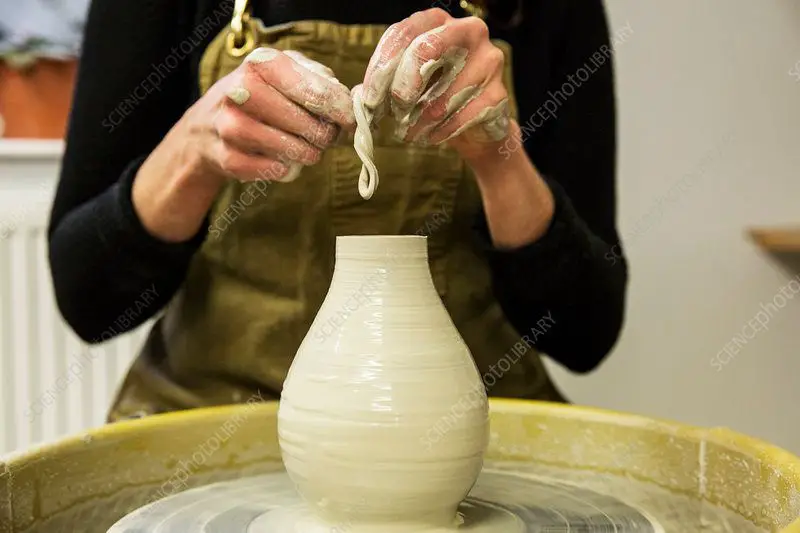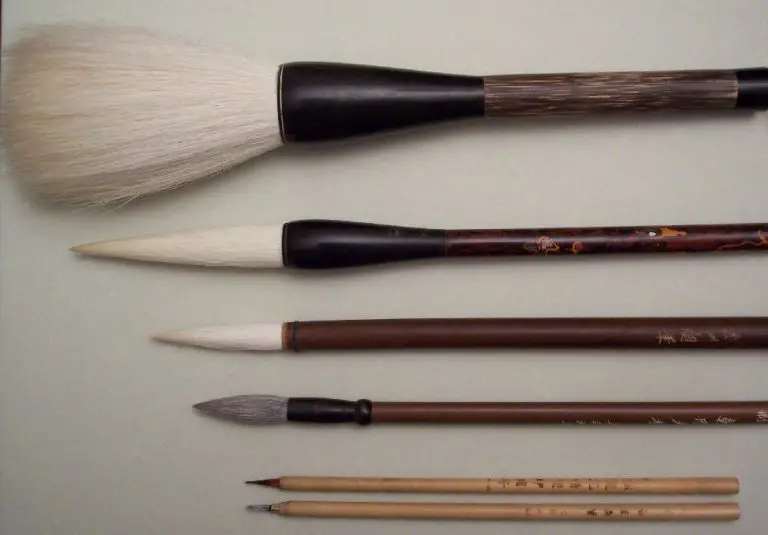What Is The Significance Of Potter’S Wheel?

Pottery making dates back over 20,000 years ago to ancient cultures in East Asia and the Near East [1]. Early potters shaped clay vessels by hand, but the invention of the potter’s wheel revolutionized ceramic production. A potter’s wheel is a rotating horizontal disk that allows potters to raise and shape clay into symmetrical ceramic forms with ease and precision. The potter’s wheel enabled faster, higher volume production and new creative possibilities for ceramic art and design. Over thousands of years, the potter’s wheel spread around the world and became an essential technology that transformed pottery making. The wheel’s efficiency and standardization significantly impacted manufacturing, trade, culture, and archaeology globally. This overview will explore the potter’s wheel’s origins, evolution, artistic impact, cultural influences, economic effects, and modern relevance.
Origins
The earliest evidence of potter’s wheels comes from Mesopotamia, where they first emerged around 3500-3000 BCE. The earliest potter’s wheels were relatively simple devices made of wood, clay or stone. A common early design was the “tournette”, which consisted of a flat disk that was spun by hand or with a stick while the potter shaped the clay vessel. Some archaeologists believe the first potter’s wheels may have developed from ancient spindle whorls used for spinning thread (Gardencrafthome).
From Mesopotamia, use of the potter’s wheel spread to other regions over the next thousand years. Potter’s wheels appeared in Ancient Egypt by around 2500 BCE, having likely diffused from Mesopotamia. Chinese potters had adopted the wheel by around 2000 BCE. In the Indus Valley civilization, potter’s wheels were in use by around 1700 BCE. The technique then spread across South and Central Asia. Potter’s wheels reached the Mediterranean by around 1000 BCE, spreading to Ancient Greek and Roman potters. According to some scholars, the diffusion of the potter’s wheel from Mesopotamia facilitated increased ceramic specialization across many cultures (Academia.edu).
Technological Advances
The potter’s wheel has undergone many innovations and developments throughout history to improve its design and function. The earliest wheels were rotary devices that required the potter to turn the wheel continuously with their hands or feet. This changed with the invention of the kick wheel around 2500 BCE in Mesopotamia, which used the potter’s feet to turn a large flywheel connected to the rotating disk.[1] This flywheel momentum allowed the potter to temporarily stop kicking and form the pot with both hands free.
Further improvements led to the development of the momentum wheel or self-propelled wheel in ancient Egypt around 1800 BCE. This used a hand crank and transmission system to maintain the disk’s spinning momentum without continuous kicking.[2] The potter’s wheel continued to be refined over the centuries, transitioning to treadle wheels operated by foot pedals in China during the Han Dynasty around 150 BCE.
Modern pottery wheels from the 20th century onward have integrated electric motors for automatic spinning. Computerized wheels with pre-programmed spin rates and foot pedal controls offer advanced control over speed and direction.[2] These technological advances have increased production efficiency and enabled innovative new pottery forms and designs.
Manufacturing Impact
The invention of the potter’s wheel enabled a huge leap forward in ceramic manufacturing. By allowing the potter to rotate the clay while shaping it, the wheel enabled much faster and more consistent production [1]. Whereas previously pots were made by hand building techniques that limited output, the wheel enabled mass production of ceramic vessels. Ancient pottery workshops quickly scaled up production, increasing volume while also improving quality and consistency [2].
The potter’s wheel required less physical labor from the potter, but greater skill. Instead of relying on hand molding techniques, the potter had to learn to center and shape rotating clay. This led to specialization, with skilled wheel potters producing vessels far more efficiently. The consistency provided by wheel-throwing also enabled pottery to be produced in standardized sets rather than as one-off pieces. Together, these factors drove pottery in many cultures from a handicraft to a mass-produced industry.
Artistic Possibilities
The invention of the potter’s wheel enabled new artistic possibilities in ceramic ware. The rotational momentum of the wheel allowed potters to throw vessels into more uniform shapes and with thinner walls than could be achieved by handbuilding techniques alone. This allowed for new rounded forms like bottles, vases, bowls, and plates to be crafted with ease.1
The precision afforded by the wheel also let artisans create pieces with more complex decorative techniques. Patterned reliefs could be etched or stamped onto the surface while the clay was still wet and rotating on the wheel. Delicate thin-walled vessels could be intricately painted as well. Glazes could also be used to create colorful finishes. The uniformity and precision of wheel-thrown pieces made these decorative techniques much easier to execute consistently.2
So while handbuilding and coiling techniques had been used for centuries to create basic functional pottery, the wheel opened up new artistic possibilities in ceramic ware. The combination of the potter’s wheel and specialized decorative techniques marked a revolution in the artistry and complexity of clay vessels.1
Cultural Influence
The spread of the potter’s wheel across cultures enabled new pottery styles and traditions to develop. As the wheel spread from Mesopotamia to Europe, Asia, and the Middle East, potters were able to create more uniform, delicate, and intricate pieces. This allowed distinctive regional pottery styles to emerge, like Ancient Greek Black and Red Figure pottery, Chinese celadon ware, and Islamic lusterware 1.
The potter’s wheel also facilitated trade and cultural diffusion. Lightweight, wheel-thrown ceramics like amphorae were easy to transport and enabled goods to be traded over long distances across the Mediterranean and Asia. As pottery spread, so did artistic styles and technological innovations associated with wheel-based pottery production 2. This helped disseminate new techniques and aesthetic ideas across cultures.
By enabling mass production of ceramics, the potter’s wheel transformed pottery from functional craft to global commodity. As a result, pottery became an important economic driver and means of cultural exchange in early civilizations across Europe, the Middle East, and Asia.
Economic Effects
The invention of the potter’s wheel enabled pottery to become a major commercial industry. By allowing potters to quickly and efficiently produce large quantities of nearly identical vessels, the wheel transformed pottery production into a volume-based business. According to The Economics of Pottery Production, the introduction of the potter’s wheel lowered barriers to entry in the pottery trade through its efficiency gains. This allowed many more people to become potters, greatly increasing the overall volume and availability of pottery goods.
The expanded market for pottery supported the rise of specialized artisan and merchant classes that centered around the pottery trade. As pottery became a specialized skill, artisans could devote themselves full-time to improving their craft. Merchants focusing solely on buying and selling pottery could also thrive by meeting the booming consumer demand. The potter’s wheel enabled these economic shifts by transforming pottery from a small-scale household activity into a core engine of commerce and industry.
Archaeological Insights
The advent of the potter’s wheel revolutionized ceramic manufacture and provides valuable insights into ancient cultures. Wheel-thrown pottery is more uniform in shape and thinner than handmade ware. The presence of wheelmade pottery at an archaeological site indicates a certain level of technological sophistication.
In Mesopotamia, the earliest known wheelmade pottery dates back to 3500 BC. The technology spread across the ancient world over the next two millennia. Sites containing wheelmade pottery can be dated to the Bronze Age or later. The styles and forms of wheelmade ceramics also allow archaeologists to trace trade networks and cultural connections between different civilizations.
For example, Cyprus was an important intermediary in maritime trade between the Aegean, Egypt, and the Near East during the Late Bronze Age. Archaeologists have excavated shipwrecks containing distinctive Cypriot pottery that was widely exported. Analyzing the clay composition and painted designs distinguishes imports from locally produced Cypriot ware at other sites. This exchange of ceramic goods reflects the island’s extensive trade links.
Overall, the potter’s wheel enabled mass production of ceramics and greatly expanded their availability and usage in daily life. The archaeological study of wheelmade pottery provides insights into manufacturing innovations, trade patterns, cultural diffusion, and dating at sites across the ancient world.
Modern Relevance
The potter’s wheel continues to play an important role in pottery and ceramic production today. While more rudimentary and foot-powered wheels have largely been replaced by modern electric-powered wheels, the basic concept remains the same. The rotational movement allows potters to efficiently shape clay into symmetrical vessels with thinner walls and distinctive patterns.
The potter’s wheel is still widely used by professional ceramic artists, hobby potters, and large-scale manufacturers. It enables the creation of intricate pottery that would be difficult to produce by hand alone. While new technologies like 3D printing have emerged for manufacturing, the traditional wheel remains unmatched for making one-of-a-kind pieces with artistic flair. The combination of craftsmanship and centrifugal force allows for graceful curves and fine surface detailing.
The potter’s wheel requires practice and skill to master, much like learning to ride a bike. Once the techniques are honed, it becomes an extension of the potter’s hands. While innovations will continue to evolve production methods, the potter’s wheel endures as an iconic tool synonymous with the art of pottery. Its rhythmic, meditative practice connects modern makers to millennia of human history.
Conclusion
The potter’s wheel has had a significant impact on human civilization. Its invention revolutionized the production of pottery and enabled the mass production of ceramic goods. Key points discussed include its origins in Mesopotamia, the technological advances that allowed wheels to be more versatile and efficient, and the major boost it provided to manufacturing.
Artistically, the wheel expanded the possibilities for pottery and ceramic art. It allowed potters to standardize and perfect techniques and create more intricate, delicate, and artistic pieces. Culturally, it enabled the proliferation of pottery for daily use, storage, trade, and ritual. Economically, it supported major industries and trade networks. Archaeologically, pottery remains provide insights into ancient cultures.
While methods have evolved, the potter’s wheel remains in use today around the world. It continues to be an important tool for artisans and pottery manufacturers. The potter’s wheel revolutionized humanity’s ability to work with clay and profoundly impacted the advance of civilization. Its inventions facilitated trade, culture, and technology across societies.



